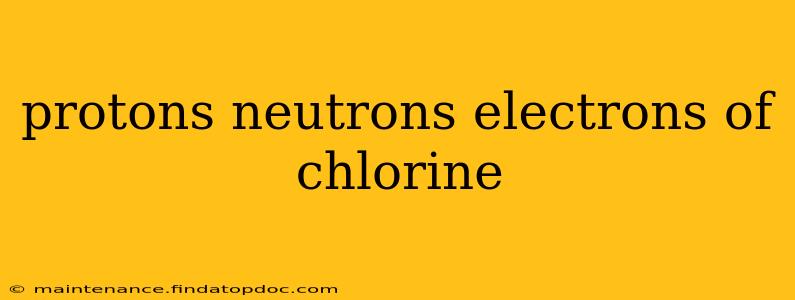Chlorine, a crucial element in our everyday lives, plays a vital role in various processes, from water purification to the production of essential chemicals. Understanding its atomic structure, particularly the number of protons, neutrons, and electrons, is key to grasping its properties and behavior. This comprehensive guide delves into the specifics of chlorine's atomic composition and answers frequently asked questions surrounding this important element.
How many protons, neutrons, and electrons does chlorine have?
Chlorine (Cl) has an atomic number of 17. This atomic number directly dictates the number of protons, which is always 17. A neutral chlorine atom will also have 17 electrons, balancing the positive charge of the protons. The number of neutrons, however, varies depending on the isotope of chlorine. The most common isotopes are Chlorine-35 (³⁵Cl) and Chlorine-37 (³⁷Cl). Chlorine-35 has 18 neutrons (35 - 17 = 18), while Chlorine-37 has 20 neutrons (37 - 17 = 20).
What is the atomic mass of chlorine?
The atomic mass of chlorine is approximately 35.45 atomic mass units (amu). This is not a whole number because it represents a weighted average of the masses of its naturally occurring isotopes, Chlorine-35 and Chlorine-37. Since Chlorine-35 is more abundant (around 76%), its mass significantly influences the overall average atomic mass.
What are the isotopes of chlorine?
As mentioned earlier, the two primary isotopes of chlorine are Chlorine-35 (³⁵Cl) and Chlorine-37 (³⁷Cl). Isotopes are atoms of the same element with the same number of protons but a different number of neutrons. This difference in neutron count leads to variations in atomic mass, but not in chemical properties. Both isotopes behave similarly in chemical reactions.
How many valence electrons does chlorine have?
Chlorine has 7 valence electrons. These are the electrons in the outermost shell of the atom, and they play a crucial role in determining the element's chemical reactivity. Chlorine readily gains one electron to achieve a stable octet (8 electrons in its outer shell), making it highly reactive and prone to forming chemical bonds, often with a -1 oxidation state.
Why is chlorine important?
Chlorine's importance stems from its wide-ranging applications. Its disinfecting properties are invaluable in water purification, ensuring safe drinking water for millions. It's also a key component in the production of numerous chemicals, including PVC (polyvinyl chloride) plastic, solvents, and various other industrial chemicals. Furthermore, chlorine compounds are used in numerous everyday products, from bleaches to pharmaceuticals.
What is the electron configuration of chlorine?
The electron configuration of chlorine is 1s²2s²2p⁶3s²3p⁵. This shows the arrangement of electrons in different energy levels (shells and subshells) within the atom. The 7 electrons in the 3s and 3p subshells are the valence electrons.
This detailed breakdown provides a comprehensive understanding of the protons, neutrons, and electrons of chlorine, highlighting its atomic structure and its significance in various aspects of our lives. Understanding these fundamental aspects of chlorine is crucial for anyone studying chemistry or related fields. The information presented here is based on established scientific principles and data.
